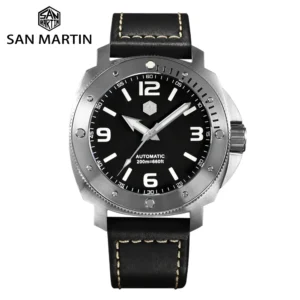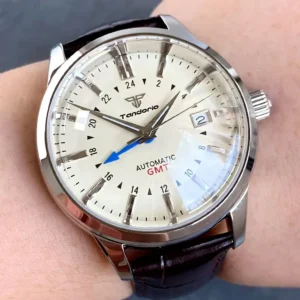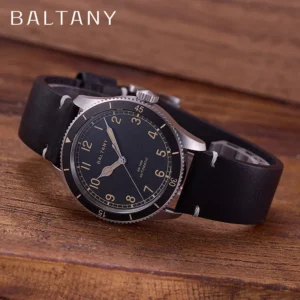Understanding the Beauty of Bronze Oxidation
Bronze, a remarkable alloy primarily composed of copper and tin, has captivated humanity for thousands of years. This versatile metal combines the distinct properties of its component elements, creating a material that’s not only durable but develops a unique character over time through oxidation. When bronze oxidizes, it creates what’s known as patina – a natural protective layer that forms on the surface, telling the story of the object’s journey through time.
For watch cases and decorative items, bronze oxidation isn’t merely a chemical process – it’s a desirable characteristic that adds depth, character, and individuality to each piece. Unlike other metals that simply corrode and deteriorate, bronze transforms, with its warm copper tones gradually shifting to rich browns, vibrant greens, and occasionally, subtle blues.
This guide explores the fascinating world of bronze oxidation, distinguishing between the desirable patina that collectors cherish and problematic corrosion that requires attention. We’ll examine the science behind the process, factors that influence patination, and methods to either enhance, maintain, or remove patina based on your preferences.
The beauty of bronze lies in its living nature – each piece evolves differently based on its environment and handling, making it uniquely appealing to those who appreciate history and dive watch engineering. Whether you’re considering adding a bronze timepiece to your collection or already own stunning bronze automatic watches, understanding oxidation will help you appreciate and care for these exceptional pieces.
The Composition of Bronze: Foundation for Oxidation
Bronze isn’t a single, standardized material but rather a family of alloys with varying compositions that directly influence how they oxidize and develop patina. The standard composition typically includes copper with approximately 12-12.5% tin, but numerous variations exist, each with distinct properties and oxidation characteristics.
Common bronze alloys include:
- Traditional bronze: Primarily copper with 12% tin, it develops a classic, relatively uniform patina
- Aluminum bronze: Contains 3-10% aluminum with copper and offers increased corrosion resistance, developing a more subdued, golden-toned patina
- Silicon bronze: Includes approximately 3% silicon, creating a harder alloy with excellent corrosion resistance and a more reddish patina
- Phosphor bronze: Contains small amounts of phosphorus (0.5-1.0%), known for its springiness and more reddish-brown patination
The precise composition dramatically affects how the metal will react with the environment. Higher tin content generally creates a darker, more stable patina, while alloys with aluminum tend to maintain more of their original color for longer periods. Watchmakers carefully select specific bronze formulations based on their desired aesthetic and patination effects.
The oxidation behavior of bronze directly stems from the electrochemical properties of its component metals. Copper, as the primary element, largely drives the oxidation process, while tin and other metals modify the reaction rate and the resulting colors. This relationship between composition and oxidation forms the foundation of what makes each bronze watch case unique in its aging process.
The Science Behind Bronze Oxidation
At its core, bronze oxidation is a series of chemical reactions between the metal surface and its environment. When bronze is exposed to air, the copper component initially reacts with oxygen to form copper oxide (Cu₂O), creating a thin, often reddish-brown layer. This first stage happens relatively quickly, sometimes within days of exposure to air.
As time progresses, this initial oxide layer reacts further with moisture, carbon dioxide, and other environmental compounds to form more complex substances. Copper carbonates, copper hydroxides, and various other copper compounds develop on the surface, creating the characteristic greens and blues often associated with aged bronze. These compounds form at different rates depending on environmental conditions:
- The initial oxide layer forms first (days to weeks)
- Basic copper carbonates develop next (weeks to months)
- More stable compounds continue forming (months to years)
What makes bronze patina particularly fascinating is its layered structure. Examination under a microscope would reveal different chemical compounds arranged in distinct strata, with newer reactions occurring at the surface while more stable compounds remain closer to the metal. This multi-layered structure contributes to the depth and complexity of colors in well-developed patina.
Crucially, unlike rust on iron which is destructive, properly formed patina actually serves as a protective barrier. Once established, this stable patina layer significantly slows further oxidation by limiting oxygen access to the underlying metal. This self-protecting quality explains why ancient bronze artifacts can survive thousands of years with their structural integrity intact.
The timeline for bronze watch patina development varies dramatically based on numerous factors, but generally, noticeable changes begin within weeks of exposure, with rich character developing over months and years of wear.
Environmental Factors Affecting Bronze Oxidation
The environment surrounding a bronze piece plays a crucial role in determining how quickly and in what manner oxidation occurs. Understanding these factors helps explain why bronze cases develop such distinctive and personalized patinas.
Humidity and Moisture
– High humidity environments dramatically accelerate oxidation
– Consistent moisture exposure creates more uniform patination
– Cyclic wet/dry conditions often produce more textured, uneven patinas
– Submerged bronze (like on diving equipment) develops different compounds than air-exposed bronze
Air Pollutants
– Sulfur dioxide (common in urban environments) creates darker, sometimes blackish patinas
– Nitrogen oxides can contribute to green coloration
– Carbon dioxide influences the formation of basic copper carbonates
– Industrial areas typically produce faster, more dramatic patination
Salt Exposure
– Coastal environments with salt-laden air create distinctive blue-green patinas
– Salt accelerates the oxidation process significantly
– Sweat from skin contact introduces both salt and acids to the bronze
– Salt exposure can potentially lead to more problematic corrosion if not properly managed
Temperature Effects
– Higher temperatures generally accelerate chemical reactions
– Thermal cycling (daily temperature changes) can create stress in the patina layer
– Cold environments typically slow patination but don’t stop it entirely
– Heat can deepen and darken existing patinas
UV Exposure
– Ultraviolet light can affect certain patina compounds
– Can accelerate color changes in some environments
– May break down protective oils or waxes applied to bronze
The interaction between these factors explains why a bronze watch worn daily in a coastal city will develop a completely different character than an identical model kept in a dry, climate-controlled collection. These environmental variations create the unique “story” that each bronze piece tells through its patina.
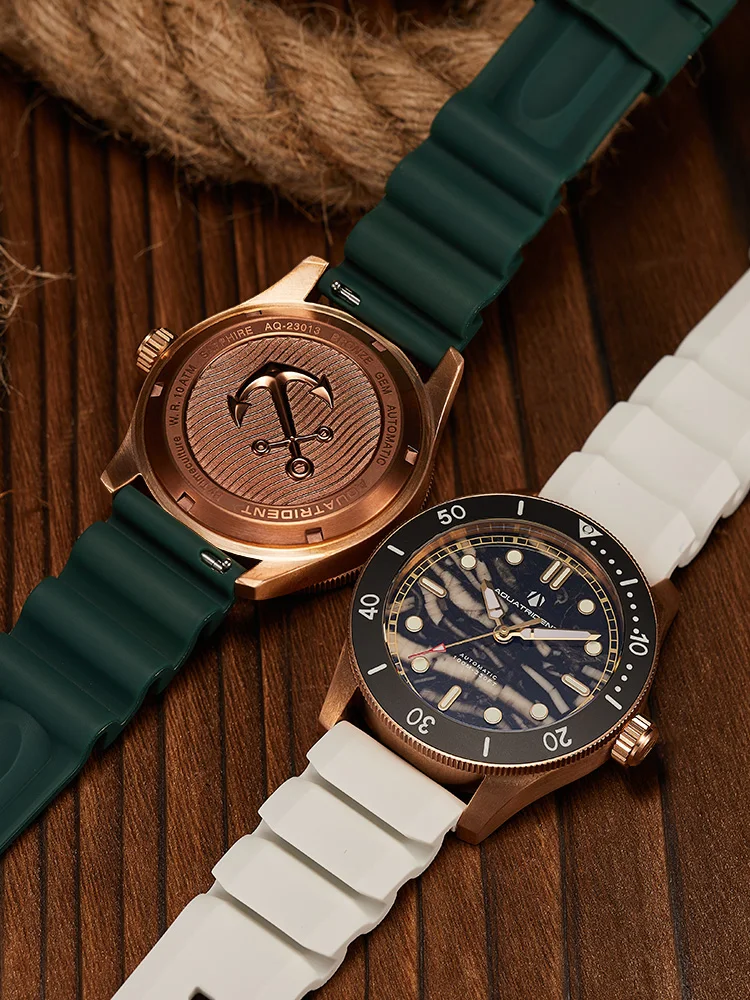
The Human Factor: How Contact Affects Bronze Patina
While environmental conditions create the foundation for patina development, human interaction adds another fascinating dimension to how bronze cases age. The oils, acids, and physical contact from handling and wearing bronze items significantly influence their patination story.
Skin Oils and Acids
The natural oils in human skin contain compounds that interact with bronze surfaces. These oils can either accelerate or inhibit oxidation depending on their composition, which varies from person to person. Areas of a bronze watch that make frequent skin contact often develop distinct patination patterns compared to less-touched areas.
Individual Sweat Composition
Each person’s sweat has a unique chemical profile, containing varying levels of:
– Sodium chloride (salt)
– Lactic acid
– Urea
– Ammonia compounds
– Amino acids
These differences explain why the same bronze watch model can develop dramatically different patinas when worn by different individuals. Some people notice their bronze watches age naturally much faster than others, a phenomenon directly linked to their body chemistry.
The “Green Wrist” Effect
Many bronze watch wearers occasionally experience the “green wrist” phenomenon—a temporary green or bluish discoloration on the skin where the watch contacts the body. This happens when copper compounds transfer from the patinated surface to the skin, especially during sweaty activities. Though harmless and washable, this effect demonstrates the active nature of bronze patina.
Physical Contact and Polishing Effects
Frequent handling creates natural “high points” on bronze cases:
– Edges and corners often appear polished from regular contact
– Recessed areas maintain darker patina
– Areas touched during normal use (like bezels and crowns) develop distinctive wear patterns
– These contact patterns create a natural highlighting effect prized by many collectors
This human interaction element makes bronze watches particularly personal items, as they literally record the wearing habits and body chemistry of their owner, creating a unique historical record that other materials simply cannot match.
The Aesthetic Appeal of Bronze Patina
The allure of patinated bronze extends far beyond its technical characteristics—it represents a visual and emotional connection that many find deeply appealing. The aesthetic qualities of bronze patina have been celebrated across cultures and centuries, from ancient sculptures to modern timepieces.
The color spectrum of bronze patina is extraordinarily diverse:
– Warm copper tones of new bronze
– Rich browns and chocolates in early patination
– Verdigris greens in more developed patinas
– Turquoise blues in certain environmental conditions
– Russet and amber tones in protected areas
– Blackened accents in recessed details
This natural variation creates depth and dimensionality that uniform materials simply cannot achieve. Moreover, the development of patina represents the passage of time itself—each mark and color shift tells a story of the object’s journey through the world.
The uniqueness factor cannot be overstated. Even two identical bronze watches, purchased on the same day, will develop entirely different characters over time based on where and how they’re worn. This individuality appeals strongly to those who value authentic experiences over mass production, making each bronze piece a one-of-a-kind possession.
The heritage and vintage appeal also resonates with many enthusiasts. Bronze carries historical weight as one of humanity’s oldest and most important alloys, connecting modern objects to thousands of years of tradition. The aging process of bronze mimics our own human experience—changing, developing character, and recording experiences over time.
This appreciation for patina’s aesthetic qualities aligns perfectly with the broader philosophy behind mechanical timepieces and automatic field military watches, where craftsmanship, heritage, and personal connection take precedence over mere functionality.
Bronze Disease: When Oxidation Becomes Destructive
While most forms of bronze oxidation create desirable and protective patina, collectors should be aware of bronze disease—a destructive form of corrosion that can permanently damage bronze items if left untreated. Understanding how to identify and address this condition is crucial for proper bronze care.
Bronze disease differs fundamentally from normal patination in both cause and appearance. It results from chloride contamination that creates an ongoing cyclical reaction with copper in the bronze. Unlike stable patina, bronze disease continues to actively corrode the metal, potentially destroying the object over time.
Visual Warning Signs of Bronze Disease:
– Powdery, light green deposits (often resembling sugar or salt)
– Pitting or cratering of the bronze surface
– Bright, almost neon green spots (unlike the deeper green of healthy patina)
– Flaky, crusty, or fuzzy textures on the surface
– Progressive deterioration that worsens over time
– Spots that reappear quickly after cleaning
The danger of bronze disease lies in its self-perpetuating nature. Once established, the chloride compounds react with moisture from the air to form hydrochloric acid, which attacks more copper, creating more copper chloride in an ongoing destructive cycle.
Common sources of chloride contamination include:
– Seawater or salt air exposure
– Handling with unwashed hands (salt from skin)
– Improper cleaning with chlorine-containing compounds
– Storage in containers with PVC components
– Burial in certain soil types (archaeological finds)
Bronze disease requires intervention, unlike natural patina which stabilizes over time. If you suspect bronze disease on a valuable piece, consulting a professional conservator is recommended. For less valuable items, thorough removal of the affected area followed by protective treatment can often halt the process.
Understanding this distinction is particularly important for collectors of historical timepieces and those interested in the broader timeline of diving watch innovations, as proper identification ensures appropriate care for these valuable objects.
Preserving and Managing Bronze Patina
For many bronze enthusiasts, maintaining the current state of patina represents the ideal approach—neither forcing additional oxidation nor removing what has naturally developed. Proper preservation techniques allow you to “freeze” your bronze item at your preferred stage of patination.
Optimal Storage Practices:
– Store bronze items in dry environments with stable humidity (ideally 40-50%)
– Use acid-free materials for any storage containers or pouches
– Avoid direct contact with leather, wood, or other materials that might trap moisture
– Include silica gel packets when storing for extended periods
– Ensure adequate air circulation to prevent condensation
Gentle Cleaning Methods:
1. Use distilled water with mild, pH-neutral soap
2. Clean with soft brushes or microfiber cloths only
3. Rinse thoroughly to remove all soap residue
4. Dry immediately and completely using soft, lint-free cloths
5. Allow additional air-drying time before storage
Protective Coating Options:
– Renaissance wax: A microcrystalline wax offering excellent protection
– Museum-grade waxes: Specifically formulated for bronze preservation
– Clear acrylic lacquers: Provide longer-lasting but less natural protection
– Specialized bronze protectants: Products designed specifically for bronze watches
Protective coatings create a barrier between the bronze and the environment, effectively “locking in” the current state of patina. However, they require periodic reapplication as they naturally wear away with handling and exposure.
For watches specifically, special attention should be paid to areas around gaskets and seals, as these functional components shouldn’t be compromised by patination processes or protective treatments. The bronze watch care guide provides additional watch-specific maintenance tips.
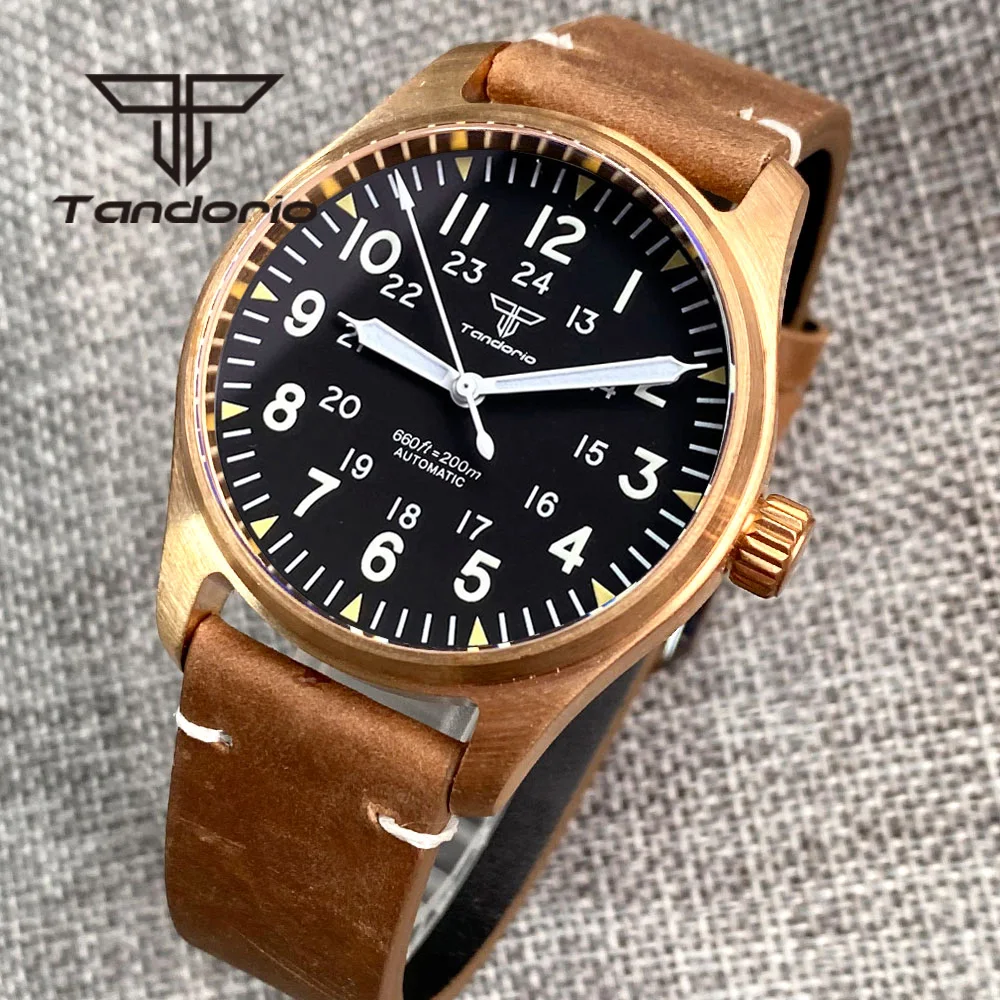
Remember that even with proper preservation techniques, bronze remains a living material that will continue to evolve gradually over time—this subtle aging is part of its enduring charm.
Removing Patina: Methods and Considerations
While many appreciate the aged appearance of patinated bronze, others prefer the bright, warm glow of newly polished bronze. Whether you’re restoring a neglected piece or simply prefer the unoxidized appearance, several methods can effectively remove accumulated patina.
Household Patina Removal Methods:
Vinegar and Salt Solution
– Mix equal parts white vinegar and salt to create a paste
– Apply to bronze surface with a soft cloth
– Let sit for 5-30 minutes depending on patina thickness
– Gently scrub with a soft brush
– Rinse thoroughly with clean water and dry immediatelyLemon Juice and Baking Soda
– Create a paste using lemon juice and baking soda
– Apply to patinated areas
– Allow to work for 5-10 minutes
– Scrub gently with a soft brush
– Rinse thoroughly and dry completelyCommercial Bronze Cleaners
– Use according to manufacturer instructions
– Often more aggressive than household methods
– Usually contain mild acids or chelating agents
– May provide more uniform results
Important considerations when removing patina:
- Each cleaning removes a microscopic layer of the actual bronze, not just the patina
- Repeated cleanings can eventually affect details and dimensions
- Areas with intricate engraving or fine details require extra care
- Once cleaned, bronze will immediately begin oxidizing again unless protected
- Uneven cleaning can create blotchy appearance worse than complete patina
After cleaning, applying a protective coating is essential if you wish to maintain the bright finish. Without protection, the bronze will begin reoxidizing immediately upon exposure to air, often developing a reddish-brown color within days.
For those interested in the historical context of bronze finishes in watchmaking, understanding the evolution of dive watch technology provides valuable perspective on how different manufacturers have approached bronze case finishing throughout history.
Creating Controlled Patina: Forced Patination Methods
For those who appreciate patinated bronze but don’t want to wait months or years for natural development, forced patination offers a way to accelerate and control the process. This approach allows for specific color development and more uniform results than natural aging.
Common Forced Patination Methods:
Ammonia Fumigation
– Place bronze item in sealed container
– Include a small open container of ammonia (not touching the bronze)
– Allow fumes to interact with the bronze surface (4-24 hours)
– Results in blue-green patinas of varying intensity
– Ventilation is crucial for this methodLiver of Sulfur (Potassium Sulfide)
– Mix liver of sulfur with warm water per instructions
– Dip bronze item or apply with brush
– Development occurs within minutes
– Creates deep browns to blacks
– Can be diluted for more controlled resultsVinegar and Salt Vapor
– Mix vinegar with salt in a container
– Suspend bronze above the mixture (not touching)
– Seal in container for 6-24 hours
– Creates mottled greens and blues
– Less aggressive than direct application
Important Safety Precautions:
– Always work in well-ventilated areas
– Wear appropriate protective gloves
– Use eye protection when working with any chemicals
– Keep all chemicals away from food preparation areas
– Follow proper disposal procedures for used solutions
After achieving the desired effect, neutralizing and sealing the patina is essential. This typically involves:
1. Rinsing thoroughly in clean water
2. Neutralizing any acidic or alkaline residue
3. Drying completely
4. Applying a protective wax or sealer
Forced patination allows for creative expression and can produce striking results, but it’s important to experiment on test pieces before applying techniques to valuable items. The results can vary significantly based on the specific bronze alloy, application method, and environmental conditions.
For those interested in high-performance timepieces with distinctive finishing, exploring our professional spec dive watches collection may provide inspiration for potential patination aesthetics.
Special Considerations for Bronze Watch Cases
Bronze watch cases present unique considerations compared to other bronze items due to their frequent handling, exposure to various environments, and close contact with the skin. Watch manufacturers carefully engineer these pieces to balance the appeal of patination with practical wearability.
Bronze Alloy Selection in Watchmaking:
Different manufacturers select specific bronze alloys based on their desired patination characteristics:
– CuSn8 (copper with 8% tin): Popular for its balanced patination rate
– CuAl (aluminum bronze): Chosen for slower, more controlled oxidation
– Custom proprietary alloys: Developed to achieve specific color development
– Marine-grade bronze variants: Selected for enhanced corrosion resistance
Daily Wear Considerations:
– Strap Interaction: Leather straps can be stained by bronze compounds, while rubber or textile straps resist this transfer
– Case Back Materials: Many bronze watches feature stainless steel or titanium case backs to prevent skin reactions
– Crown and Bezel Function: Patination can affect the smooth operation of rotating bezels and crowns
– Water Resistance: Oxidation generally doesn’t compromise water resistance, but attention to gaskets is important
Movement Protection:
Watch manufacturers incorporate various barriers to protect the movement from oxidation effects:
– Inner soft iron cages
– Stainless steel movement holders
– Special gaskets and seals
– Protective coatings on vulnerable components
The development of patina on a bronze watch typically follows predictable patterns based on use:
– Bezels often show the most pronounced patina due to frequent handling
– Case sides develop more uniform coloration
– Recessed areas and engravings trap compounds, creating darker accents
– Areas contacting the wrist often show polishing from natural abrasion
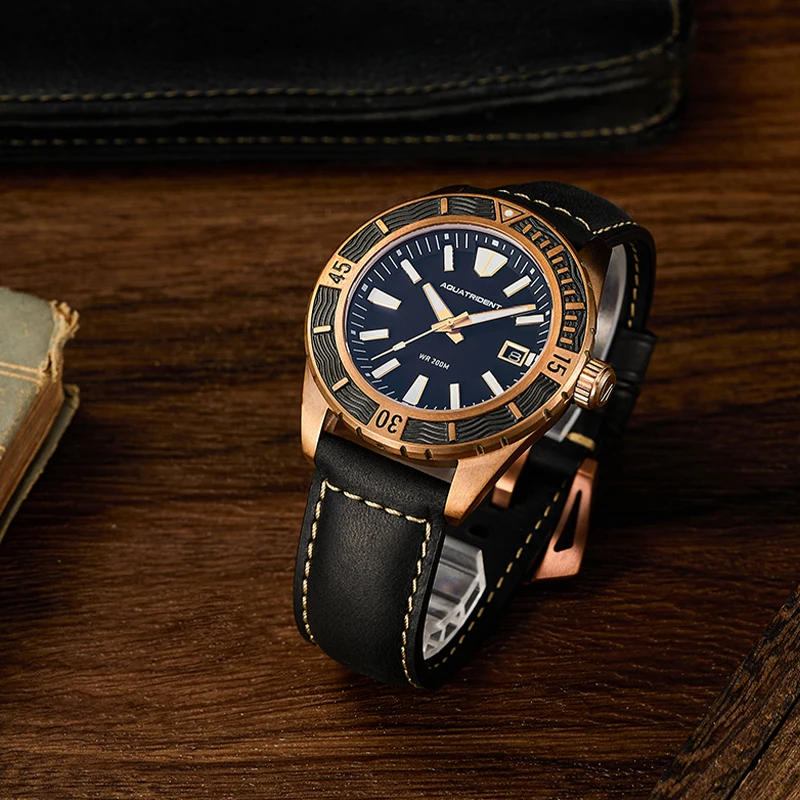
For those specifically interested in bronze timepieces with classic styling, our classic style dive watches collection features several bronze options that showcase how traditional designs interact with this living material.
Military Inspired Automatic Watches, Rugged Automatic Watches, Tactical Automatic Watches
Price range: $852.14 through $994.60 Select options This product has multiple variants. The options may be chosen on the product pageAutomatic Chronograph Watches, Classic Style Dive Watches
$3,053.06 Select options This product has multiple variants. The options may be chosen on the product pageBronze Automatic Watches, Military Inspired Automatic Watches, Professional Spec Dive Watches
Price range: $1,442.21 through $1,442.82 Select options This product has multiple variants. The options may be chosen on the product pageProfessional Spec Dive Watches, Titanium Automatic Watches
$574.74 Select options This product has multiple variants. The options may be chosen on the product pageClassic Automatic Dress Watches, GMT Automatic Watches, GMT Dive Watches
Price range: $468.93 through $552.94 Select options This product has multiple variants. The options may be chosen on the product pageClassic Pilot Watches, Military Inspired Automatic Watches
$561.00 Select options This product has multiple variants. The options may be chosen on the product page
Health and Safety Considerations
While bronze patina is generally safe and even desirable, there are several health and safety considerations worth understanding, particularly for items like watches that maintain prolonged contact with the skin.
Skin Reactivity and Bronze:
– True copper allergies are relatively rare (affecting approximately 2-4% of people)
– More common are skin irritations from copper compounds in the patina
– Individual sensitivity varies dramatically
– Reactions typically appear as redness, itching, or skin discoloration
– Switching to watches with non-bronze case backs often resolves skin issues
Skin Discoloration:
– Green or blue-green skin discoloration (not a rash) is common with bronze watches
– This is not an allergic reaction but a transfer of copper compounds
– The discoloration washes off easily and is not harmful
– Using barrier creams or switching wrist positions can reduce transfer
– More prevalent during sweaty activities or hot weather
Chemical Safety with Patination:
When working with patination chemicals, observe these precautions:
– Work in well-ventilated areas only
– Avoid mixing cleaning solutions (particularly ammonia and acids)
– Store all chemicals out of reach of children and pets
– Wear appropriate protective equipment (gloves, eye protection)
– Label all solutions clearly and dispose of them properly
Natural vs. Chemical Patina:
– Naturally developed patina is non-toxic and safe for handling
– Some forced patination chemicals can leave residues requiring neutralization
– Always thoroughly rinse and seal bronzes after chemical patination
– When in doubt about a chemical treatment, consult professional conservators
For those with sensitive skin who still appreciate the aesthetic of bronze, many automatic dive watches incorporate bronze elements while using alternative materials for surfaces that contact the skin directly.
FAQ: Common Questions About Bronze Oxidation
Does bronze rust like iron?
No, bronze doesn’t rust in the same way iron does. Rust (iron oxide) is destructive and flaky, continuing until the iron is consumed. Bronze develops patina—a stable protective layer that actually shields the underlying metal from further oxidation.
How long does it take for bronze to develop patina?
Initial color changes begin within days of exposure to air. A light patina develops over weeks, while rich, character-filled patina can take months to years depending on environmental conditions and handling.
Can patina be prevented entirely?
Yes, but it requires consistent effort. Regular cleaning and application of protective coatings like wax or lacquer can significantly slow or nearly halt patination. However, any lapse in this maintenance will allow oxidation to begin.
Is green patina harmful?
Generally no. The green patina (typically copper carbonate) is stable and actually protects the bronze underneath. However, powdery green spots that reappear after cleaning could indicate bronze disease, which is harmful and requires treatment.
Will bronze eventually deteriorate completely?
Properly maintained bronze can last for thousands of years. Archaeological finds demonstrate bronze’s remarkable durability. Unlike iron oxidation, bronze patina is self-limiting and protective rather than continuously destructive.
How can I maintain my bronze case’s current appearance?
Apply a quality microcrystalline wax or museum-grade protectant, store the piece in a low-humidity environment, and handle it with clean, dry hands. Reapply protective coatings periodically as they wear away.
Can I restore my bronze to its original color?
Yes, various cleaning methods using mild acids (lemon juice, vinegar) or commercial bronze cleaners can remove patina. However, each cleaning removes a microscopic layer of bronze, so frequent polishing isn’t recommended for detailed or valuable items.
For more specific information about bronze timepieces and their care, exploring our collection of bronze automatic watches can provide additional insights into how different designs accommodate the living nature of this material.
Embracing the Living Character of Bronze
The journey through bronze oxidation reveals something profound about this ancient alloy—it isn’t static but rather a living material that evolves alongside its owner. Unlike modern materials engineered for unchanging permanence, bronze embraces change, developing a visual record of its experiences through its patina.
This distinctive quality separates bronze from nearly all other metals used in fine objects. The warm glow of new bronze, the rich browns of developing patina, and the complex greens and blues of mature oxidation all represent chapters in an ongoing story—one unique to each piece and its journey through the world.
The key to appreciating bronze lies in understanding the difference between beneficial patina and harmful corrosion. With proper knowledge, you can guide your bronze pieces toward beautiful aging while protecting them from destructive processes. Whether you choose to preserve, remove, or encourage patina becomes a matter of personal preference rather than right or wrong.
Perhaps most compelling is how bronze creates genuinely one-of-a-kind objects. Even mass-produced bronze items diverge in appearance over time, each developing distinctive characteristics based on how and where they’re used. This individualization process creates a personal connection that few other materials can match.
In an age of disposable products and planned obsolescence, bronze stands as a testament to materials that improve rather than degrade with time. Its living character reminds us that beauty often comes not from perfection, but from the authentic recording of experience—a philosophy that resonates deeply with those who appreciate fine craftsmanship and the passage of time.


